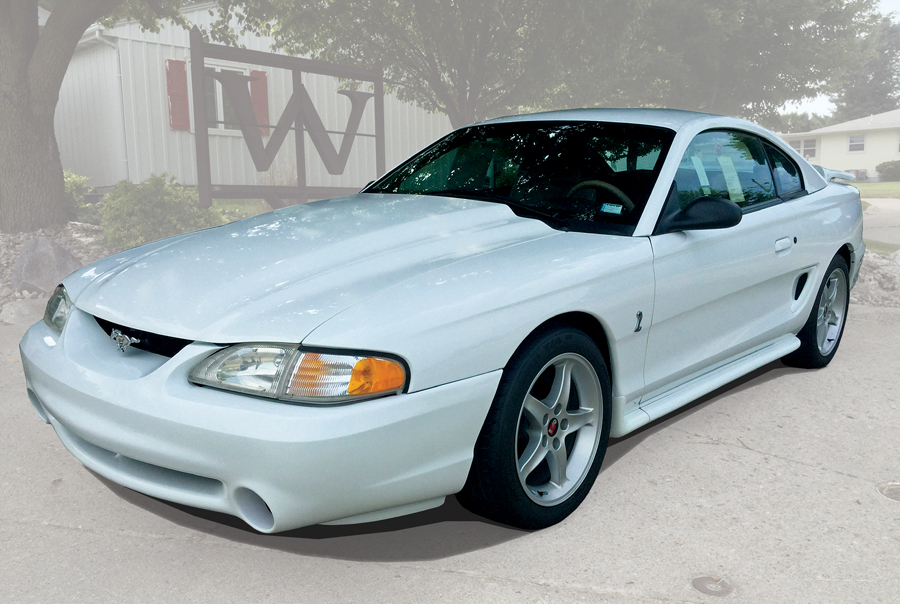- Number 38 of 250 cars built in 1995
- 5.8-L V8, 5-speed manual
- Manual seats and windows, rear seat delete
- Initially sold only to customers holding a competition license
- All original, no dealer prep
- 318 actual miles
- Paint correction, recent ceramic coating
- Factory invoice, window sticker, Ford Certificate of Authenticity
SCM Analysis
Detailing
| Vehicle: | 1995 Ford Mustang SVT Cobra R |
| Years Produced: | 1995 |
| Number Produced: | 250 |
| Original List Price: | $38,000 |
| SCM Valuation: | $31,000 |
| Tune Up Cost: | $300 (estimate) |
| Chassis Number Location: | Driver’s side dash, under windshield |
| Engine Number Location: | Right side of block |
| Alternatives: | 1995 Chevrolet Camaro Z28 1LE, 1993 Ford Mustang Cobra R, 2003 Ford Mustang Cobra |
| Investment Grade: | C |
This car, Lot 478, sold for $38,500, including buyer’s premium, at Barrett-Jackson’s Las Vegas auction held October 3–5, 2019.
For as far back as any of us can remember, the allure drawn to a product through its appearance or exclusivity has been a cornerstone of marketing. Every ad man worth his scotch and pitch cards knows that giving a product a little sex appeal is the easiest way to score top dollar and move units.
If you are selling cars to guys, make the car curvy, make it look fast, and put a nice-looking girl in the ad next to it. Simple, right?
Or you can do what Ford did when introducing the 1995 Mustang Cobra R and strip the car of all options, color choices and outward sex appeal, do very little marketing and sell all of them before they were even produced to people who needed to meet licensing requirements.
Okay, so I left a few key points out that do appeal to men buying cars. The sex appeal here lies in the intended use of the car, and that was to take it racing.
The mystique lies in the 250 produced, so to own one means that you are a perceived member of the global automotive elite, right? Uh, sure.
A new Mustang
The SN-95 Mustang was launched in 1994, looking like a committee-designed jellybean with a spoiler. While not aesthetically offensive, it never blew anyone’s hair back. It did, however, incorporate some classic Mustang design cues: The three-bar taillights look nostalgic if you are lying down, and the door scoops don’t tie into the fender line quite right, but it was a nice try.
The Cobra R package, however, was dull by design. The only color was white — why bother with anything flashier when the cars were destined to be stickered up by race sponsors? The bulged hood was developed specifically for the R and was necessary to cover the added deck height of the 351. The Cobra R wheels were a highlight and looked especially good on the pre-’93 Fox-body cars.
Faster Pony
The R was a good step up for Ford in terms of performance. The iconic 5.0, in its last year of Mustang production, was given the boot for its stroked brother, the 351 Windsor, producing 300 horsepower and 365 ft-lb of torque. Those were good numbers, but consider the Camaro Z28 was pushing 275 hp from a 350-ci mill. A stronger Tremec 5-speed transmission dealt with the additional power nicely and kept shifts smooth, long after the T-5 would have lost its third-gear blocker ring.
The R was packed with other race goodies too — goodies that pointed its use directly at the track, even though Ford knew much of the equipment would be changed out.
Cooling was a main focus, with a bigger radiator and power-steering cooler. Cooling the occupants was out, as the a/c system was left on the factory shelf for weight savings. There was extra cooling for the two-piston PBR brakes through the factory fog-light holes, and it was desperately needed.
The progressive-rate springs, while stiffer, were usually tossed in favor of a specific rate, and the tan bar stools called front seats were put to work in front of a video-game system for your 10-year-old, whom you weren’t taking for a ride because the back seat was left at the factory, too.
A market price
This particular car sold where it should in today’s market. Being a 318-mile example, the only eye-opener is the “paint correction” stated in the auction description. That could mean the seller’s 10-year-old whacked it with the lawn mower in the garage while on a break from his video games, but it’s also a required step in most modern ceramic-coating processes. Either way, it did not seem to have an effect on price.
Unfortunately, being the blandest of the R-model variants, these cars aren’t quite getting the love that they deserve in the marketplace.
There were many R cars that did get raced, but there were still plenty that got put away for future speculation, just like this one.
Hindsight being 20/20, if you were a speculator in 1995, you got clobbered on your investment of the $38,000 MSRP. If there was ever a time to buy one of these, it’s now, even though appreciation has been flat. Paying $38,500 today is like paying $19,000 for one 24 years ago, which is what you would have paid for a brand-new GT coupe.
While I don’t see these going through the roof anytime soon, a car like this should hedge inflation. Modern Mustang popularity is increasing, and guys like me remember these fondly from our early 20s. The new owner won’t lose money here — but I hope sex appeal for the model was the driving force here.
(Introductory description courtesy of Barrett-Jackson.)
